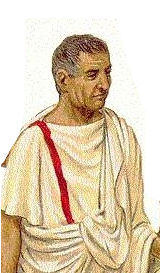Usage and significance
The angusticlavia was the tunic associated with the rank and office of the eques , or equestrians, one of the two highest legal orders in aristocratic Rome. Order members were military men, often patricians (patrici), who served as the cavalry units in war. During times of peace they frequently served as personal assistants to Roman senators. Equestrians wore the angusticlavia under the trabea , a short toga of distinctive form and color. They also wore equestrian shoes ( calcei ), and a gold ring ( anulus aureus ). The tunic's stripes were about an inch wide, which contrasted with the senator's laticlavus , which bore three-inch wide stripes. [2] [3]
The angusticlavia's purple-hued bands distinguished members of the equestrian order from other Roman dignitaries and from regular citizens. In ancient Rome, the color purple became increasingly linked to the higher classes, and eventually to the emperor and the empire's magistrates. Thus, the angusticlavia served to indicate social status above regular citizenry but below senators and magistrates. [4] [5] [6] [7]
On certain occasions, particularly during times of political or social upheaval, senators in Rome chose to wear the equestrian tunic as a public display of distress. This practice was part of the semi-egalitarian legacy of the Republic. In 58 BCE, when the tribune of the plebs Clodius was pushing Cicero into exile, the senators took on the angusticlavia in public protest. In 53 BCE, during a period of civic violence, the consuls put aside their senatorial dress (the laticlavus) and summoned the Senate in equestrian attire (the angusticlavia). [8] Over the course of ancient Roman history, the angusticlavia lost its symbolic meaning and class association. Wall paintings and other representations of the Roman past "show all types of men and boys wearing stripes of similar width – but there were later attempts to enforce or reintroduce the senatorial and equestrian classes". [9]
This page is based on this
Wikipedia article Text is available under the
CC BY-SA 4.0 license; additional terms may apply.
Images, videos and audio are available under their respective licenses.
